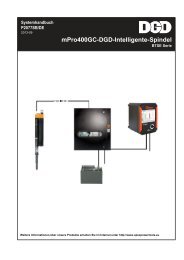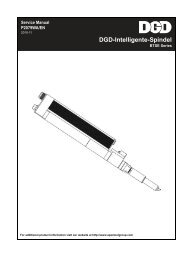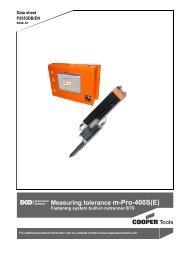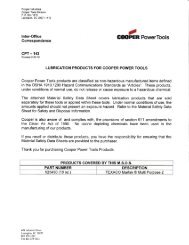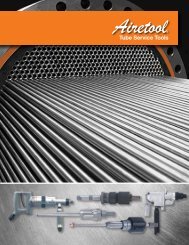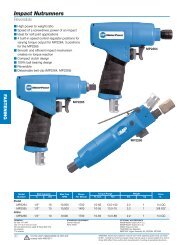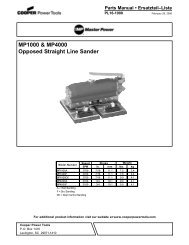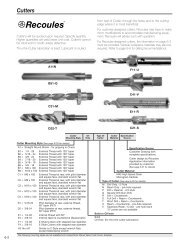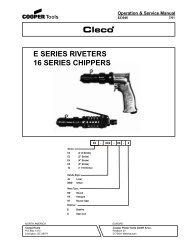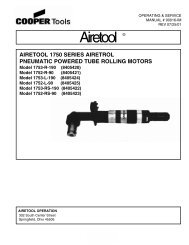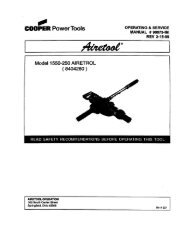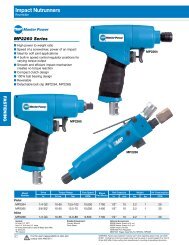158QGDA-15RAB-SU-RS RIGHT ANGLE DRILLS - Apex Tool Group
158QGDA-15RAB-SU-RS RIGHT ANGLE DRILLS - Apex Tool Group
158QGDA-15RAB-SU-RS RIGHT ANGLE DRILLS - Apex Tool Group
Create successful ePaper yourself
Turn your PDF publications into a flip-book with our unique Google optimized e-Paper software.
Safety Recommendations<br />
!<br />
The spindle on right angle positive feed drills retracts at a much<br />
faster rate than it feeds. Care should be taken to avoid entrapment.<br />
Nose pieces usually used with these drills are generally slotted for<br />
visibility and access to chuck, cutter, and retract stop adjustments.<br />
A spindle guard should be used when operating tool. Spindle<br />
guards in one inch increments are available to accommodate any<br />
length spindle. Slotted spindle guards are available for tools with<br />
fluid swivels.<br />
Drilling or other use of this tool may produce hazardous fumes and/<br />
or dust. To avoid adverse health effects utilize adequate ventilation<br />
and/or a respirator. Read the material safety data sheet for any<br />
cutting fluids or materials involved in the drilling process.<br />
!<br />
CAUTION<br />
!<br />
!<br />
WARNING<br />
WARNING<br />
Keep hands and fingers away from<br />
slot in spindle guard and nose piece<br />
when handling or operating tool.<br />
WARNING<br />
Wear respirator where<br />
necessary.<br />
• Most dusts are combustible. See material safety data sheets for<br />
combustibility of a specific dust.<br />
• Non ferrous metal dusts are particularly haxardous.<br />
Examples: Aluminum, Magnesium, Titanium, Zirconium<br />
(Never collect Magnesium in a dry dust collector)<br />
• Never collect spark generating material in the same dust collector<br />
with combustible material.<br />
Examples: Collecting both Steel and Aluminum dust or Steel and<br />
Titanium dust.<br />
• Never use flamable finishing lubricants.<br />
Some individuals are susceptible to disorders of the hands and arms<br />
when exposed to tasks which involve repetitive work motions. Those<br />
individuals predisposed to vasculatory or circulatory problems may<br />
be particularly susceptible. Cumulative trauma disorders such as<br />
carpal tunnel syndrome and tendinitis may be caused or aggravated<br />
by repetitious, forceful exertions of the hands and arms. These<br />
disorders develop gradually over periods of weeks, months, and<br />
years.<br />
Avoid OK Avoid Avoid OK Avoid<br />
Extension Neutral Flexion Radial Deviation Neutral Ulnar Deviation<br />
• Tasks should be performed in such a manner that the wrists<br />
are maintained in a neutral position, which is not flexed,<br />
hyperextended, or turned side to side.<br />
• Stressful postures should be avoided and can be controlled<br />
through tool selection and work location.<br />
Any tool operator should be aware of the following warning signs and<br />
symptoms so that a problem can be addressed before it becomes a<br />
debilitating injury. Any user suffering prolonged symptoms of tingling,<br />
numbness, blanching of fingers, clumsiness or weakened<br />
grip, nocturnal pain in the hand, or any other disorder of the<br />
shoulders, arms, wrists, or fingers is advised to consult a physician.<br />
If it is determined that the symptoms are job related or aggravated<br />
by movements and postures dictated by the job design, it may be<br />
necessary for the employer to take steps to prevent further occurrences.<br />
These steps might include, but are not limited to, repositioning<br />
the workpiece or redesigning the workstation, reassigning workers<br />
to other jobs, rotating jobs, changing work pace, and/or changing<br />
the type of tool used to minimize stress on the operator. Some tasks<br />
may require more than one type of tool to obtain the optimum<br />
operator/tool/task relationship.<br />
The following recommendations will help reduce or moderate the<br />
effects of repetitive work motions. The operator of any drill should:<br />
• Use a minimum hand grip force consistent with proper control and<br />
safe operation<br />
• Keep body and hands warm and dry<br />
• Avoid anything that inhibits blood circulation<br />
— Smoking Tobacco<br />
— Cold Temperatures<br />
— Certain Drugs<br />
• Avoid awkward postures<br />
• Keep wrists as straight as possible<br />
• Interrupt work activities, or rotate jobs to provide periods free from<br />
repetitive work motions.<br />
3



